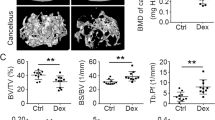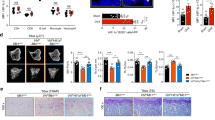Abstract
Cross-talk has been shown to occur between the immune system and bone metabolism pathways. In the present study, we investigated the impact of CD4+CD25+Foxp3+ regulatory T (Treg) cells on osteoclastogenesis and bone resorption. Treg cells that were isolated and purified from peripheral blood mononuclear cells (PBMCs) of healthy adults inhibited both the differentiation of osteoclasts (OCs) from human embryo bone marrow cells (BMCs) and the pit formation in a dose-dependent manner. In cell cocultures, the production levels of both interleukin-10 (IL-10) and transforming growth factor-beta 1 (TGF-β1) were proportionally upregulated as the ratio of Treg cells to BMCs was increased, and the inhibition of OC differentiation and bone resorption by Treg cells was completely reversed by anti-IL-10 and anti-TGF-β1 antibodies. Treatment of BMC and Treg cell cocultures with 17β-estradiol (E2) at concentrations between 10−7 and 10−9 mol/l suppressed OC differentiation and bone resorption more efficiently than it did in cultures of BMCs alone; this enhanced suppression occurred via the stimulation of Treg cell IL-10 and TGF-β1 expression. These data suggest that Treg cells suppress OC differentiation and bone resorption by secreting IL-10 and TGF-β1. E2 enhances the suppressive effects of Treg cells on OC differentiation and bone resorption by stimulating IL-10 and TGF-β1 secretion from these cells. Therefore, Treg cell-derived IL-10 and TGF-β1 are likely involved in the regulation of E2 on bone metabolism and represent potential therapeutic targets for the treatment of postmenopausal osteoporosis (PMO).
This is a preview of subscription content, access via your institution
Access options
Subscribe to this journal
Receive 12 digital issues and online access to articles
$119.00 per year
only $9.92 per issue
Buy this article
- Purchase on Springer Link
- Instant access to full article PDF
Prices may be subject to local taxes which are calculated during checkout






Similar content being viewed by others
References
Walsh MC, Kim N, Kadono Y, Rho J, Lee SY, Lorenzo J et al. Osteoimmunology: interplay between the immune system and bone metabolism. Annu Rev Immunol 2006; 24: 33–63.
Teitelbaum SL . Bone resorption by osteoclasts. Science 2000; 289: 1504–1508.
D'Amelio P, Grimaldi A, Di Bella S, Tamone C, Brianza SZ, Ravazzoli MG et al. Estrogen deficiency increases osteoclastogenesis up-regulating T cells activity: a key mechanism in osteoporosis. Bone 2008; 43: 92–100.
Tanaka S, Takahashi N, Udagawa N, Tamura T, Akatsu T, Stanley ER et al. Macrophage colony-stimulating factor is indispensable for both proliferation and differentiation of osteoclast progenitors. J Clin Invest 1993; 91: 257–263.
Theill LE, Boyle WJ, Penninger JM . RANKL and RANK: T cells, bone loss, and mammalian evolution. Annu Rev Immunol 2002; 20: 795–823.
Lam J, Takeshita S, Barker JE, Kanagawa O, Ross FP, Teitelbaum SL . TNF-alpha induces osteoclastogenesis by direct stimulation of macrophages exposed to permissive levels of RANK ligand. J Clin Invest 2000; 106: 1481–1488.
Takayanagi H . Osteoimmunology: shared mechanisms and crosstalk between the immune and bone systems. Nat Rev Immunol 2007; 7: 292–304.
Lubberts E, Koenders MI, van den Berg WB . The role of T-cell interleukin-17 in conducting destructive arthritis: lessons from animal models. Arthritis Res Ther 2005; 7: 29–37.
Kobayashi K, Takahashi N, Jimi E, Udagawa N, Takami M, Kotake S et al. Tumor necrosis factor alpha stimulates osteoclast differentiation by a mechanism independent of the ODF/RANKL–RANK interaction. J Exp Med 2000; 191: 275–286.
Lee SK, Lorenzo J . Cytokines regulating osteoclast formation and function. Curr Opin Rheumatol 2006; 18: 411–418.
Luo CY, Wang L, Sun C, Li DJ . Impact of IL-10 and TGF-beta1 from CD4+CD25+ regulatory T cells on the osteoclast differentiation and bone resorption. Chin J Endocrinol Metab 2009; 25: 434–437.
Arron JR, Choi Y . Osteoimmunology: bone versus immune system. Nature 2000; 408: 535–536.
Mundy GR . Osteoporosis and inflammation. Nutr Rev 2007; 65: S147–S151.
Kim YG, Lee CK, Nah SS, Mun SH, Yoo B, Moon HB . Human CD4+CD25+ regulatory T cells inhibit the differentiation of osteoclasts from peripheral blood mononuclear cells. Biochem Biophys Res Commun 2007; 357: 1046–1052.
Zaiss MM, Axmann R, Zwerina J, Polzer K, Guckel E, Skapenko A et al. Treg cells suppress osteoclast formation: a new link between the immune system and bone. Arhritis Rheum 2007; 56: 4104–4112.
Lee SH, Kim T, Jeong D, Kim N, Choi Y . The tec family tyrosine kinase Btk regulates RANKL-induced osteoclast maturation. J Biol Chem 2008; 283: 11526–11534.
Kruisbeek AM, Shevach E, Thornton AM . Proliferative assays for T cell function. Curr Protoc Immunol 2004: Chapter 3: 3.12.11–3.12.15 .
Roodman GD . Regulation of osteoclast differentiation. Ann NY Acad Sci 2006; 1068: 100–109.
van Amelsfort JM, Jacobs KM, Bijlsma JW, Lafeber FP, Taams LS . CD4+CD25+ regulatory T cells in rheumatoid arthritis: differences in the presence, phenotype, and function between peripheral blood and synovial fluid. Arthritis Rheum 2004; 50: 2775–2785.
Cao D, van Vollenhoven R, Klareskog L, Trollmo C, Malmstrom V . CD25brightCD4+ regulatory T cells are enriched in inflamed joints of patients with chronic rheumatic disease. Arthritis Res Ther 2004; 6: R335–R346.
Nakajima T, Ueki-Maruyama K, Oda T, Ohsawa Y, Ito H, Seymour GJ et al. Regulatory T-cells infiltrate periodontal disease tissues. J Dent Res 2005; 84: 639–643.
Ernst CW, Lee JE, Nakanishi T, Karimbux NY, Rezende TM, Stashenko P et al. Diminished forkhead box P3/CD25 double-positive T regulatory cells are associated with the increased nuclear factor-kappaB ligand (RANKL+) T cells in bone resorption lesion of periodontal disease. Clin Exp Immunol 2007; 148: 271–280.
Kelchtermans H, Geboes L, Mitera T, Huskens D, Leclercq G, Matthys P . Activated CD4+CD25+ regulatory T cells inhibit osteoclastogenesis and collagen-induced arthritis. Ann Rheum Dis 2009; 68: 744–750.
Hori S, Nomura T, Sakaguchi S . Control of regulatory T cell development by the transcription factor Foxp3. Science 2003; 299: 1057–1061.
Fontenot JD, Gavin MA, Rudensky AY . Foxp3 programs the development and function of CD4+CD25+ regulatory T cells. Nat Immunol 2003; 4: 330–336.
Askenasy N, Kaminitz A, Yarkoni S . Mechanisms of T regulatory cell function. Autoimmun Rev 2008; 7: 370–375.
Riggs BL . The mechanism of estrogen regulation of bone resorption. J Clin Invest 2006; 106: 1203–1204.
Tai P, Wang J, Jin H, Song X, Yan J, Kang Y et al. Induction of regulatory T cells by physiological level estrogen. J Cell Physiol 2008; 214: 456–464.
Mohamed SG, Sugiyama E, Shinoda K, Taki H, Hounoki H, Abdel-Aziz HO et al. Interleukin-10 inhibits RANKL-mediated expression of NFATc1 in part via suppression of c-Fos and c-Jun in RAW264.7 cells and mouse bone marrow cells. Bone 2007; 41: 592–602.
Evans KE, Fox SW . Interleukin-10 inhibits osteoclastogenesis by reducing NFATc1 expression and preventing its translocation to the nucleus. BMC Cell Biol 2007; 8: 1–9.
Park-Min KH, Ji JD, Antoniv T, Reid AC, Silver RB, Humphrey MB et al. IL-10 suppresses calcium-mediated costimulation of receptor activator NF-kappa B signaling during human osteoclast differentiation by inhibiting TREM-2 expression. J Immunol 2009; 183: 2444–2455.
Fox SW, Evans KE, Lovibond AC . Transforming growth factor-β enables NFATc1 expression during osteoclastogenesis. Biochem Biophys Res Commun 2008; 366: 123–128.
Acknowledgements
We thank the volunteers for generously participating in this study. This work was supported by the National Key Research Program of China (No. 2006CB944007; to DJL), the National Natural Science Foundation of China (No. 30801502; to LW), the Shanghai Leading Academic Discipline Project B117 (to DJL) and the Program for Outstanding Medical Academic Leaders (to DJL).
Author information
Authors and Affiliations
Corresponding author
Rights and permissions
About this article
Cite this article
Luo, C., Wang, L., Sun, C. et al. Estrogen enhances the functions of CD4+CD25+Foxp3+ regulatory T cells that suppress osteoclast differentiation and bone resorption in vitro. Cell Mol Immunol 8, 50–58 (2011). https://doi.org/10.1038/cmi.2010.54
Received:
Revised:
Accepted:
Published:
Issue Date:
DOI: https://doi.org/10.1038/cmi.2010.54
Keywords
This article is cited by
-
Metabolic bone disorders and the promise of marine osteoactive compounds
Cellular and Molecular Life Sciences (2024)
-
Single-cell and bulk RNA sequencing reveals Anoikis related genes to guide prognosis and immunotherapy in osteosarcoma
Scientific Reports (2023)
-
Modulation of bone remodeling by the gut microbiota: a new therapy for osteoporosis
Bone Research (2023)
-
Sex differences in the inflammatory response to stroke
Seminars in Immunopathology (2023)
-
Periodontal ligament cells under mechanical force regulate local immune homeostasis by modulating Th17/Treg cell differentiation
Clinical Oral Investigations (2022)



